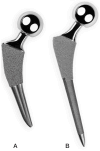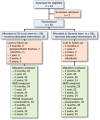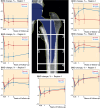Similar femoral stem fixation but less metaphyseal loss of bone mineral density with a taper-wedge design and diaphyseal bone preservation with a long and round-tapered design: a 5-year randomized RSA and DXA study of 50 patients
- PMID: 40891927
- PMCID: PMC12404101
- DOI: 10.2340/17453674.2025.43907
Similar femoral stem fixation but less metaphyseal loss of bone mineral density with a taper-wedge design and diaphyseal bone preservation with a long and round-tapered design: a 5-year randomized RSA and DXA study of 50 patients
Abstract
Background and purpose: The new Tri-Lock bone -preserving stem with a collarless proximal-coated tapered-wedge design was compared with a classic well-proven collarless proximal-coated long and round-tapered design. Our primary aim was to compare femoral stem fixation (subsidence) of the Tri-Lock stem with the classic Summit stem, and secondarily to compare the change in periprosthetic bone mineral density (BMD) and PROMS between stem groups.
Methods: In a patient-blinded randomized controlled trial, 52 patients at mean age 60 (SD 6) received cementless Tri-Lock (n = 26) or Summit (n = 26) femoral stems with a cementless Pinnacle cup, a cross-linked polyethylene liner, and a CoCr head. Patients were followed for 5 years with radiostereometric analysis (RSA), dual-energy X-ray absorptiometry (DXA), and patient-reported outcome measures (PROMs). We measured mean (CI) values of migration and periprosthetic bone mineral density and calculated between group differences.
Results: At 2-year follow-up, the mean difference in subsidence was 0.14 mm (95% confidence interval [CI] -0.27 to 0.56) and below the chosen minimal clinically important difference of 0.6 mm. At 5-year follow-up, for the Tri-Lock and Summit stems, the mean subsidence was 0.38 (CI 0.04-0.72) and 0.24 (CI 0.09-0.57), and the mean retroversion was 1.68° (CI 0.80-2.55) and 1.53° (CI 0.68-2.37), respectively. There was initial periprosthetic BMD loss for both stems. At 5-year follow-up, the mean metaphyseal bone loss was minimal for the Tri-Lock stem (zone 1: -2.8% vs -11.5%) while the Summit stem preserved the medial diaphyseal bone better (zone 6: -7.1% vs -13.6%). At the medial stem tip, BMD was increased with the Summit stem (zone 5: +3.4% vs -1.5%). At 5-year follow-up, median EQ5D was 1 in both groups and median Oxford Hip Score was 47 (Tri-Lock) and 45 (Summit) with no statistical significant differences between groups.
Conclusion: The Tri-Lock and the Summit stems displayed similar migration until mid-term follow-up. At 3 months both stems had lost metaphyseal periprosthetic bone mineral density (BMD). During the following years, the new design regained more metaphyseal BMD. Contrarily, the long and round-tapered stem design regained or even increased diaphyseal BMD. PROM scores improved beyond the reference level for both groups.
Figures




References
-
- Thien T M, Chatziagorou G, Garellick G, Furnes O, Havelin L I, Mäkelä K, et al. Periprosthetic femoral fracture within two years after total hip replacement: analysis of 437,629 operations in the nordic arthroplasty register association database. J Bone Joint Surg Am 2014; 96(19): e167. doi: 10.2106/jbjs.M.00643. - DOI - PubMed
-
- Burchard R, Graw J A, Soost C, Schmitt J. Stress shielding effect after total hip arthroplasty varies between combinations of stem design and stiffness: a comparing biomechanical finite element analysis. International Orthopaedics 2023; 47(8): 1981-7. doi: 10.1007/s00264-023-05825-7. - DOI - PMC - PubMed
Publication types
MeSH terms
LinkOut - more resources
Full Text Sources
Medical

